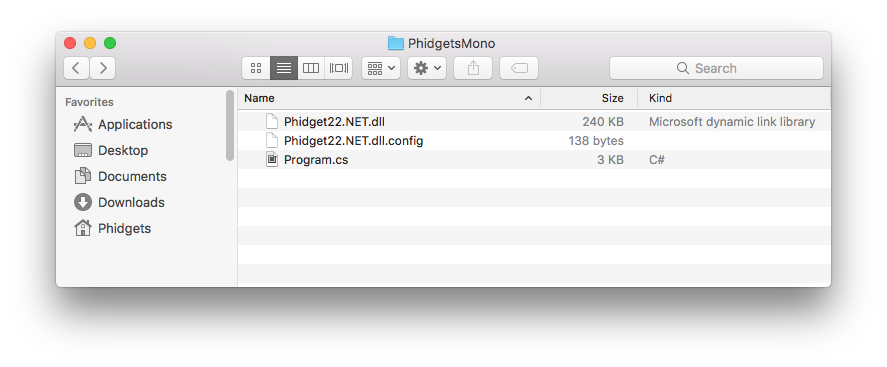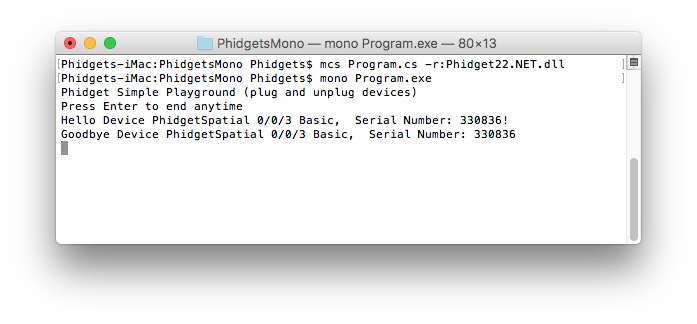Language - C Sharp macOS Mono: Difference between revisions
| Line 145: | Line 145: | ||
mono Program.exe | mono Program.exe | ||
</syntaxhighlight> | </syntaxhighlight> | ||
Success! The project now has access to Phidgets. | |||
{{Language_Further_Reading}} | {{Language_Further_Reading}} | ||
Revision as of 15:25, 5 September 2018
| C# Development Environments | ||||
|---|---|---|---|---|
|
Language - C# MacOS with Mono Welcome to using Phidgets with C#! By using C#, you will have access to the complete Phidget22 API, including events. Mono is an open-source programming environment that aims to make Microsoft .NET applications available across all operating systems. |
Install Phidget Drivers for macOS
Before getting started with the guides below, ensure you have the following components installed on your machine:
- You will need the Phidgets macOS Drivers
Use Our Examples
One of the best ways to start programming with Phidgets is to use our example code as a guide. In order to run the examples, you will need to download and install Mono for macOS. You will also need a copy of Phidget22.NET.dll.
Now that you have Mono installed and Phidget22.NET.dll on hand, download and unpack the HelloWorld example for C#:
Note: The HelloWorld example is compatible with Mono because it does not use Windows Forms. All other C# examples use Windows Forms.
Finally, you need to create a configuration file. Create a new file in the same directory as the example you wish to compile and name it Phidget22.NET.dll.config. Copy the content below to the file.
<configuration>
<dllmap dll="phidget22.dll" target="/Library/Frameworks/Phidget22.framework/Versions/Current/Phidget22" />
</configuration>
Your project directory should now look like this:

To compile the program, enter the following command in the terminal:
mcs Program.cs -r:Phidget22.NET.dll
An executable file will be created. Run the program using mono:
mono Program.exe

You should now have the example up and running for your device. Play around with the device and experiment with some of the functionality. When you are ready, the next step is editing the examples with your own code!
Editing the Examples
With the exception of the HelloWorld example mentioned earlier, the C# examples are what comprise the Windows Phidget Control Panel. These are all graphical examples, and Mono is a non-graphical environment so you'll need to modify a few things to adapt them for your own purposes. Start with copying the contents of Form1_Load from one of the examples into your mono program's main function.
Next, you can remove the following line:
commandLineData phidgetParameters = open.parseCmdLine(); //get command line parameters
Then, you can modify any line that mentions phidgetParameters by setting it to the desired value instead of using PhidgetParameters object.
For instance:
try
{ //set all the values grabbed from command line. these values have defaults that are set in ExampleUtils.cs, you can check there to see them.
digout.Channel = phidgetParameters.Channel; //selects the channel on the device to open
digout.DeviceSerialNumber = phidgetParameters.SerialNumber; //selects the device or hub to open
digout.HubPort = phidgetParameters.HubPort; //selects the port on the hub to open
digout.IsHubPortDevice = phidgetParameters.isHubPortDevice; //is the device a port on a VINT hub?
if (phidgetParameters.isRemote) //are we trying to open a remote device?
{
digout.IsRemote = true;
Net.EnableServerDiscovery(ServerType.Device); //turn on network scan
if (phidgetParameters.Password != null && phidgetParameters.ServerName != null)
Net.SetServerPassword(phidgetParameters.ServerName, phidgetParameters.Password); //set the password if there is one
}
else
digout.IsLocal = true;
digout.Open(); //open the device specified by the above parameters
}
catch (PhidgetException ex) { errorBox.addMessage("Error opening device: " + ex.Message); }
Might become:
try
{
digout.Channel = 0;
digout.DeviceSerialNumber = 370097;
digout.HubPort = 0;
digout.IsHubPortDevice = true;
digout.IsRemote = false;
digout.Open();
}
catch (PhidgetException ex) { errorBox.addMessage("Error opening device: " + ex.Message); }
You'll also have to remove some references to graphical elements such as ErrorEventBox. If you assign event handler functions, you'll have to define them before your main function, similar to the manager events in the HelloWorld example we covered earlier.
You can then manipulate the rest of the code as your application requires. A more in-depth description of programming with Phidgets will be covered in the next section.
Write Code
By following the instructions for your operating system and compiler above, you now have working examples and a project that is configured. This teaching section will help you understand how the examples were written so you can start writing your own code.
Remember: your main reference for writing C# code will be the Phidget22 API Manual and the example code.
Step One: Step One: Create and Address
You will need to declare your Phidget object in your code. For example, we can declare a digital input object like this:
DigitalInput ch = new DigitalInput();
Next, we can address which Phidget we want to connect to by setting parameters such as DeviceSerialNumber.
ch.DeviceSerialNumber = 496911;
Although we are not including it on this page, you should include error handling for all Phidget functions. Here is an example of the previous code with error handling:
try{
ch = new DigitalInput();
ch.DeviceSerialNumber = 496911;
}catch(PhidgetException ex){
Console.WriteLine("Error: " + ex.Description);
}
Step Two: Open and Wait for Attachment
After we have specified which Phidget to connect to, we can open the Phidget object like this:
ch.Open(5000);
To use a Phidget, it must be plugged in (attached). We can handle this by calling Open(timeout), which will block indefinitely until a connection is made, or until the timeout value is exceeded. Simply calling Open does not guarantee you can use the Phidget immediately.
Alternately, you could verify the device is attached by using event driven programming and tracking the attach events.
To use events, we have to modify our code slightly:
ch = new DigitalInput();
ch.Attach += onAttachHandler;
ch.Open(5000);
Next, we have to declare the function that will be called when an attach event is fired - in this case the function onAttachHandler will be called.
void onAttachHandler (object sender, Phidget22.Events.AttachEventArgs e){
attachedText.Text = "Attached";
}
We recommend using this attach handler to set any initialization parameters for the channel such as DataInterval and ChangeTrigger from within the AttachHandler, so the parameters are set as soon as the device becomes available.
Step Three: Do Things with the Phidget
We recommend the use of event driven programming when working with Phidgets. In a similar way to handling an attach event as described above, we can also add an event handler for a state change event:
ch = new DigitalInput();
ch.Attach += onAttachHandler;
ch.StateChange += onStateChangeHandler;
ch.Open();
This code will connect a function and an event. In this case, the onStateChangeHandler function will be called when there has been a change to the devices input. Next, we need to create the onStateChangeHandler function:
void onStateChangeHandler(object sender, Phidget22.Events.DigitalInputStateChangeEventArgs e) {
stateText.Text = "State: " + e.State;
}
If you are using multiple Phidgets in your program, check out our page on Using Multiple Phidgets for information on how to properly address them and use them in events.
If events do not suit your needs, you can also poll the device directly for data using code like this:
stateText.Text = "State: " + ch.State;
Important Note: There will be a period of time between the attachment of a Phidget sensor and the availability of the first data from the device. Any attempts to get this data before it is ready will result in an exception. See more information on this on our page for Unknown Values.
Enumerations
Some Phidget devices have functions that deal with specific predefined values called enumerations. Enumerations commonly provide readable names to a set of numbered options.
Enumerations with Phidgets in Visual Basic .NET will take the form of Phidget22.EnumerationType.Enumeration_Name.
For example, specifying a SensorType to use the 1142 for a voltage input would look like:
Phidget22.VoltageSensorType.PN_1142
and specifying a K-Type thermocouple for a temperature sensor would be:
Phidget22.ThermocoupleType.K
The Phidget error code for timing out could be specified as:
Phidget22.ErrorCode.Timeout
Step Four: Close and Delete
At the end of your program, be sure to close your device.
ch.Close()
Setting up a New Project
When you are building a project from scratch, or adding Phidget functionality to an exisiting project, you'll need to configure your development environment to properly link the Phidget .NET library.
To include the Phidget .NET library, simply add the following lines to the top of your code:
using Phidget22;
using Phidget22.Events;
Then, proceed to add your code to your main function.
Next, place a copy of Phidget22.NET.dll into the same directory as your program.
Finally, you need to create a configuration file. Create a new file in the same directory and name it Phidget22.NET.dll.config. Copy the content below to the file.
<configuration>
<dllmap dll="phidget22.dll" target="/Library/Frameworks/Phidget22.framework/Versions/Current/Phidget22" />
</configuration>
Your project directory should now look like this:

Open the command prompt at the directory location and enter the following command:
mcs Program.cs -r:Phidget22.NET.dll
This will create an executable file called Program.exe. Type in the following command to run your program:
mono Program.exe
Success! The project now has access to Phidgets.
Further Reading
Phidget Programming Basics - Here you can find the basic concepts to help you get started with making your own programs that use Phidgets.
Data Interval/Change Trigger - Learn about these two properties that control how much data comes in from your sensors.
Using Multiple Phidgets - It can be difficult to figure out how to use more than one Phidget in your program. This page will guide you through the steps.
Polling vs. Events - Your program can gather data in either a polling-driven or event-driven manner. Learn the difference to determine which is best for your application.
Logging, Exceptions, and Errors - Learn about all the tools you can use to debug your program.
Phidget Network Server - Phidgets can be controlled and communicated with over your network- either wirelessly or over ethernet.
